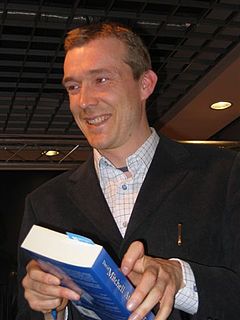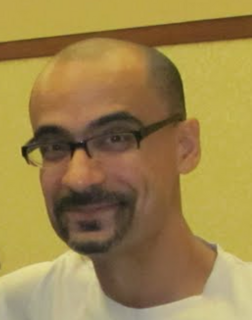An author is the creator or originator of any written work such as a book or play, and is also considered a writer. More broadly defined, an author is "the person who originated or gave existence to anything" and whose authorship determines responsibility for what was created.

Harlan Jay Ellison was an American writer, known for his prolific and influential work in New Wave speculative fiction, and for his outspoken, combative personality. Robert Bloch, the author of Psycho, described Ellison as "the only living organism I know whose natural habitat is hot water".

Theodore Sturgeon was an American fiction author, primarily of fantasy, science fiction and horror. He was also a critic. He wrote approximately 400 reviews and more than 120 short stories, 11 novels and several Star Trek scripts.

Haruki Murakami is a Japanese writer. His books and stories have been bestsellers in Japan as well as internationally, with his work being translated into 50 languages and selling millions of copies outside his native country. His work has received numerous awards, including the World Fantasy Award, the Frank O'Connor International Short Story Award, the Franz Kafka Prize, and the Jerusalem Prize.

A ghostwriter is hired to write literary or journalistic works, speeches, or other texts that are officially credited to another person as the author. Celebrities, executives, participants in timely news stories, and political leaders often hire ghostwriters to draft or edit autobiographies, memoirs, magazine articles, or other written material. In music, ghostwriters are often used to write songs, lyrics, and instrumental pieces. Screenplay authors can also use ghostwriters to either edit or rewrite their scripts to improve them.
"The City on the Edge of Forever" is the twenty-eighth and penultimate episode of the first season of the American science fiction television series Star Trek. The episode had several writers contribute to the finished product including Harlan Ellison, Steven W. Carabatsos, D. C. Fontana and Gene L. Coon. Gene Roddenberry made the final re-write. The episode was directed by Joseph Pevney and first aired on NBC on April 6, 1967.

Sue Taylor Grafton was an American author of detective novels. She is best known as the author of the "alphabet series" featuring private investigator Kinsey Millhone in the fictional city of Santa Teresa, California. The daughter of detective novelist C. W. Grafton, she said the strongest influence on her crime novels was author Ross Macdonald. Before her success with this series, she wrote screenplays for television movies.

National Novel Writing Month is an annual Internet-based creative writing project that takes place during the month of November. Participants attempt to write a 50,000-word manuscript between November 1 and November 30. Well-known authors write "pep-talks" to keep them motivated throughout the process. The website provides participants, called "Wrimos", with tips for writer's block, information on where local participants are meeting, and an online community of support. Focusing on the length of a work rather than the quality, writers are encouraged to finish their first draft quickly so that it can later be edited at the author's discretion. The project started in July 1999 with 21 participants. By the 2010 event, over 200,000 people took part and wrote a total of over 2.8 billion words.

Nora Roberts is an American author of more than 225 romance novels. She writes as J. D. Robb for the in Death series and has also written under the pseudonyms Jill March and for publications in the U.K. as Sarah Hardesty.

David Stephen Mitchell is an English novelist and screenwriter.
Collaborative fiction is a form of writing by a group of three or more authors who share creative control of a story.
Knave magazine is a long-established British pornographic magazine, published by Galaxy Publications. Originally launched in 1968, it is the upmarket sister publication of Fiesta magazine. Mary Millington modelled for the magazine in 1974, prior to her exclusive signing to work for David Sullivan's magazines.

Junot Díaz is a Dominican-American writer, creative writing professor at the Massachusetts Institute of Technology (MIT), and fiction editor at Boston Review. He also serves on the board of advisers for Freedom University, a volunteer organization in Georgia that provides post-secondary instruction to undocumented immigrants. Central to Díaz's work is the immigrant experience, particularly the Latino immigrant experience.
The interactive novel is a form of interactive web fiction. In an interactive novel, the reader chooses where to go next in the novel by clicking on a piece of hyperlinked text, such as a page number, a character, or a direction. While authors of traditional paper-and-ink novels have sometimes tried to give readers the random directionality offered by hypertexting, this approach was not completely feasible until the development of HTML. For a discussion of paper novels that use a branching structure, such as Choose Your Own Adventure novels, see the Wikipedia entry on gamebooks.

Web of the City is the first novel written by American author Harlan Ellison. The novel follows the story of Rusty Santoro, a teenage member of the fictional Cougars street gang in the 1950s Brooklyn, New York. In order to research the book, Ellison spent time in an actual street gang in Brooklyn. His book Memos from Purgatory (1961) is a non-fiction account of his time in the Barons.

Typewriter in the Sky is a science fantasy novel by American writer L. Ron Hubbard. The protagonist Mike de Wolf finds himself inside the story of his friend Horace Hackett's book. He must survive conflict on the high seas in the Caribbean during the 17th century, before eventually returning to his native New York City. Each time a significant event occurs to the protagonist in the story he hears the sounds of a typewriter in the sky. At the story's conclusion, de Wolf wonders if he is still a character in someone else's story. The work was first published in a two-part serial format in 1940 in Unknown Fantasy Fiction. It was twice published as a combined book with Hubbard's work Fear. In 1995 Bridge Publications re-released the work along with an audio edition.
Self-publishing is the publication of media by its author without the involvement of an established publisher. The term usually refers to written media, such as books and magazines, either as an ebook or as a physical copy using POD technology. It may also apply to albums, pamphlets, brochures, video content, and zines.
A novelist is an author or writer of novels, though often novelists also write in other genres of both fiction and non-fiction. Some novelists are professional novelists, thus make a living writing novels and other fiction, while others aspire to support themselves in this way or write as an avocation. Most novelists struggle to get their debut novel published, but once published they often continue to be published, although very few become literary celebrities, thus gaining prestige or a considerable income from their work.

For the silversmith and Nashville mayor, see J. T. Elliston.
This is a list of works by Harlan Ellison (1934–2018). It includes his literary output, screenplays and teleplays, voiceover work, and other fields of endeavor.











